Installing Dual SSD Drives and Bootcamp in MacBook Pro
by grenley in Circuits > Apple
127308 Views, 25 Favorites, 0 Comments
Installing Dual SSD Drives and Bootcamp in MacBook Pro
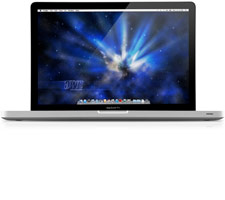
This Instructable explains one method for updating a MacBook Pro to use two Solid State Disks (SSDs) and using BootCamp to partition one SSD to support Windows 7.
An early-2011 MacBook Pro is used in this instance, but the process will be very similar for other solid body MacBook Pros. The system runs Mountain Lion, but the process is similar for Lion and probably Snow Leopard.
When you are done, you will have a SSD as your main drive, running OS X, and a second SSD split between OS X and Windows.
An early-2011 MacBook Pro is used in this instance, but the process will be very similar for other solid body MacBook Pros. The system runs Mountain Lion, but the process is similar for Lion and probably Snow Leopard.
When you are done, you will have a SSD as your main drive, running OS X, and a second SSD split between OS X and Windows.
What You'll Need
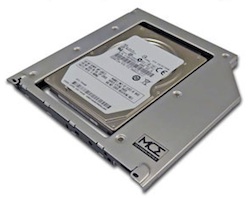
You will need:
- a Solid State Disk (SSD) drive. I bought a 500 GB unit from Other World Computing. http://www.macsales.com
- a conversion kit, aka Drive Doubler, that lets you install a second SSD in place of the DVD drive. I got mine from MCE Technologies: http://www.mcetech.com. You will want a second SSD, too.
- a teeny tiny phillips screwdriver, for opening the case.
- a teeny tiny Torx driver. Several vendors sell inexpensive tool kits; I recommend you get one.
- a large USB flash drive, on which you can install OS X and boot from it. I used a 64 GB drive.
- a second USB flash drive. This will be used as temporary storage for files needed during installation. 4 GB is plenty.
Make sure you can plug both drives in at the same time. The USB ports are close together, and sometimes the USB flash draves are too fat to fit. I used a short USB extension cable.
- a copy of Windows 7 (or other Windows flavor) on a DVD.
- a small cup in which to place the teeny tiny screws you will remove.
- a good bright light. The little screws are hard to see. You may also want a magnifying glass.
- a good internet connection.
- several hours.
You should be comfortable about dismantling your MacBook Pro. Bear in mind that this may void your warranty, depending on how cranky Apple feels like being. Many installers like to do the work on a soft cloth, so as not to scratch the Mac's case.
Other World Computing has excellent videos on working on your Mac: http://eshop.macsales.com/installvideos/
You may also want to consider upgrading your RAM while you have your system apart.
- a Solid State Disk (SSD) drive. I bought a 500 GB unit from Other World Computing. http://www.macsales.com
- a conversion kit, aka Drive Doubler, that lets you install a second SSD in place of the DVD drive. I got mine from MCE Technologies: http://www.mcetech.com. You will want a second SSD, too.
- a teeny tiny phillips screwdriver, for opening the case.
- a teeny tiny Torx driver. Several vendors sell inexpensive tool kits; I recommend you get one.
- a large USB flash drive, on which you can install OS X and boot from it. I used a 64 GB drive.
- a second USB flash drive. This will be used as temporary storage for files needed during installation. 4 GB is plenty.
Make sure you can plug both drives in at the same time. The USB ports are close together, and sometimes the USB flash draves are too fat to fit. I used a short USB extension cable.
- a copy of Windows 7 (or other Windows flavor) on a DVD.
- a small cup in which to place the teeny tiny screws you will remove.
- a good bright light. The little screws are hard to see. You may also want a magnifying glass.
- a good internet connection.
- several hours.
You should be comfortable about dismantling your MacBook Pro. Bear in mind that this may void your warranty, depending on how cranky Apple feels like being. Many installers like to do the work on a soft cloth, so as not to scratch the Mac's case.
Other World Computing has excellent videos on working on your Mac: http://eshop.macsales.com/installvideos/
You may also want to consider upgrading your RAM while you have your system apart.
Making the Bootable USB Flash Drive
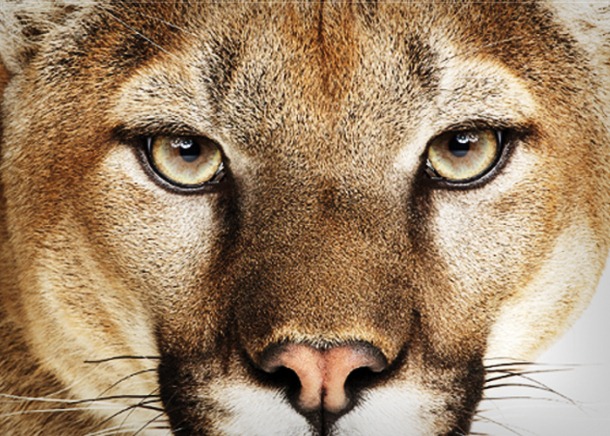
Plug your 64 GB USB flash drive into a USB port on your Mac, and use Apple's App Store to download and install a copy of Mountain Lion onto the USB flash drive. If you've already purchased Mountain Lion, you won't be charged.
Mountain Lion installation is straightforward and automatic; consult Apple's support pages if you have questions.
After installation is complete, you may wish to consider adding other system-repair utilities. I have Disk Warrior and iDefragger, and I keep this USB drive on my keychain.
Mountain Lion installation is straightforward and automatic; consult Apple's support pages if you have questions.
After installation is complete, you may wish to consider adding other system-repair utilities. I have Disk Warrior and iDefragger, and I keep this USB drive on my keychain.
Opening the Mac and Removing the DVD Drive
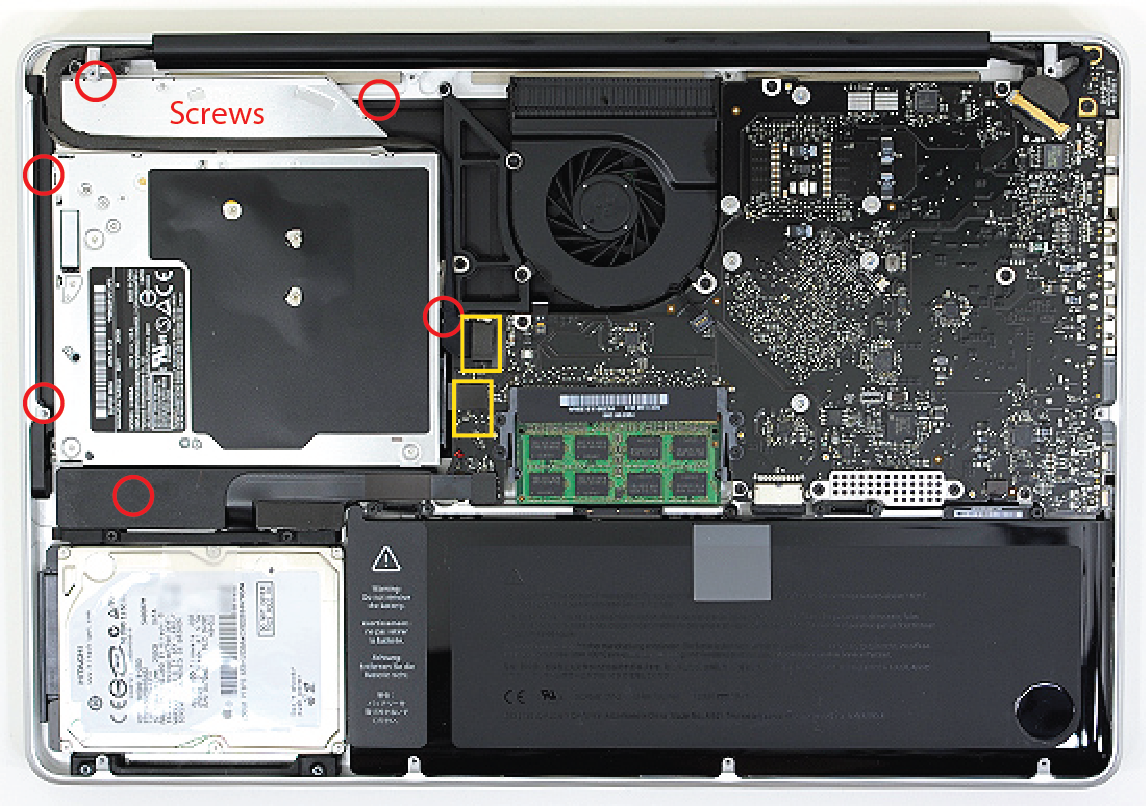
Okay, time to rip into the guts of your Mac.
- Shutdown and disconnect from power.
- Flip the Mac over, and remove the ten screws that hold the bottom cover on. Note the position of the three long ones. Place the screws in a cup where they won't get lost or scattered.
- There are several screws holding the DVD drive in. They're marked in red in the picture. Note that locations vary slightly in different models. Remove them, and note which ones go where. The screws are not ALL the same. Put them someplace safe.
- There are two small cable connectors, marked in yellow in the picture. These can be carefully pried up from the motherboard.
- When all the screws are out and the cables are disconnected, the DVD drive should remove easily. IF IT DOESN'T, stop and look for the problem. A bright light and a magnifying glass can be helpful.
- Set the DVD drive aside.
- Shutdown and disconnect from power.
- Flip the Mac over, and remove the ten screws that hold the bottom cover on. Note the position of the three long ones. Place the screws in a cup where they won't get lost or scattered.
- There are several screws holding the DVD drive in. They're marked in red in the picture. Note that locations vary slightly in different models. Remove them, and note which ones go where. The screws are not ALL the same. Put them someplace safe.
- There are two small cable connectors, marked in yellow in the picture. These can be carefully pried up from the motherboard.
- When all the screws are out and the cables are disconnected, the DVD drive should remove easily. IF IT DOESN'T, stop and look for the problem. A bright light and a magnifying glass can be helpful.
- Set the DVD drive aside.
Installing the SSD in the DVD Drive Bay

- Select the SSD drive you will want to become the primary (OS X) drive. (If both your drives are the same, this is moot, but I bought a bigger and faster drive for OS X, and a smaller, slower drive for the second drive.)
- Follow your vendor's directions for installing an SSD into the adapter that lets it fit into the DVD drive bay.
- Re-install the DVD/SSD assembly where the old DVD drive was. Carefully replace the screws and re-connect the cables.
- Put the bottom cover back in place. You don't actually need to replace the screws.
- Turn the Mac over, connect power, and boot the machine.
- Follow your vendor's directions for installing an SSD into the adapter that lets it fit into the DVD drive bay.
- Re-install the DVD/SSD assembly where the old DVD drive was. Carefully replace the screws and re-connect the cables.
- Put the bottom cover back in place. You don't actually need to replace the screws.
- Turn the Mac over, connect power, and boot the machine.
Install Mountain Lion and Migrate

SSD drives are different than rotating drives; it's best to do a clean install of Mountain Lion and let it migrate from your old drive to your new one.
Run the Mountain Lion installer, follow the prompts, and when it asks if you want to migrate, do so and select the old hard disk as the source.
Run the Mountain Lion installer, follow the prompts, and when it asks if you want to migrate, do so and select the old hard disk as the source.
Remove That SSD Drive, and the HDD, and Add Another SSD
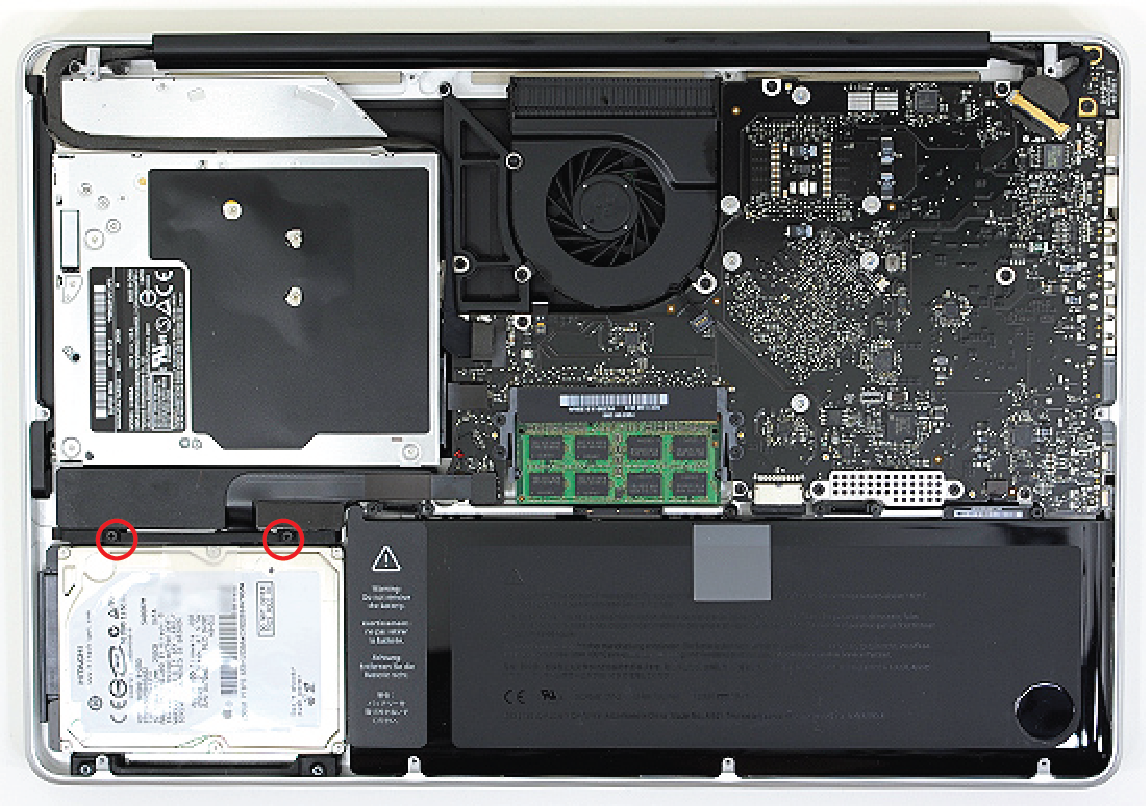
Yup, that's right. Remove the SSD drive and the adapter:
- Shut down your Mac, disconnect power, flip it open, and remove the cover.
- Remove the screws that hold the DVD/SSD adapter in place, and remove it.
- Next, remove the two screws that retain a black plastic bar that in turn retains the HDD.
- Lift the HDD out and remove the cable/connector from the drive.
- There are four cylindrical nubbins on the HDD. Remove them and place them on your SSD.
Leave the Mac open, and go on to the next step.
- Shut down your Mac, disconnect power, flip it open, and remove the cover.
- Remove the screws that hold the DVD/SSD adapter in place, and remove it.
- Next, remove the two screws that retain a black plastic bar that in turn retains the HDD.
- Lift the HDD out and remove the cable/connector from the drive.
- There are four cylindrical nubbins on the HDD. Remove them and place them on your SSD.
Leave the Mac open, and go on to the next step.
Add the DVD Drive and the Second SSD Drive

To finish the conversion:
- Install the SSD where the old HDD was, and replace the plastic bar and screws.
- Re-install the DVD drive.
- Replace the cover (again, you don't need to put the screws back) and turn the unit over.
- Connect the unit to power.
- Plug both USB flash drives into USB ports on the Mac.
- Hold the Option key down and press the power button.
You will be presented with a choice of boot devices. Select the USB flash drive.
- Install the SSD where the old HDD was, and replace the plastic bar and screws.
- Re-install the DVD drive.
- Replace the cover (again, you don't need to put the screws back) and turn the unit over.
- Connect the unit to power.
- Plug both USB flash drives into USB ports on the Mac.
- Hold the Option key down and press the power button.
You will be presented with a choice of boot devices. Select the USB flash drive.
Running BootCamp
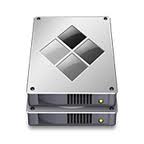
From the Utilities folder in the Applications folder, launch BootCamp.
Follow BootCamp's directions to download the required files. Specify your other USB flash drive as the destination.
BootCamp will want you to specify the portion of the SSD drive to be used for Windows, and the portion available to OS X. It's really up to you. I allowed 200 GB for Windows because I plan to run some big programs, like AutoCAD. 40 GB is generally considered the absolute minimum.
When requested by BootCamp, insert your Windows DVD into the disk slot, and let the system proceed.
The system will reboot into the Windows installer. After a bit, the Installer will ask you which of several partitions on the disk you want to use. Pick the one that is about the same size as what you spec'd earlier. (The sizes will not be exactly the same - this is normal.) Windows will complain that it is not formatted correctly. Click on the Disk option and tell Windows to format it.
Allow Windows to finish installing. This takes awhile.
When Windows is done installing, run the BootCamp utilities (in Windows) to install drivers and other bits. Consult the BootCamp directions if you have questions.
Follow BootCamp's directions to download the required files. Specify your other USB flash drive as the destination.
BootCamp will want you to specify the portion of the SSD drive to be used for Windows, and the portion available to OS X. It's really up to you. I allowed 200 GB for Windows because I plan to run some big programs, like AutoCAD. 40 GB is generally considered the absolute minimum.
When requested by BootCamp, insert your Windows DVD into the disk slot, and let the system proceed.
The system will reboot into the Windows installer. After a bit, the Installer will ask you which of several partitions on the disk you want to use. Pick the one that is about the same size as what you spec'd earlier. (The sizes will not be exactly the same - this is normal.) Windows will complain that it is not formatted correctly. Click on the Disk option and tell Windows to format it.
Allow Windows to finish installing. This takes awhile.
When Windows is done installing, run the BootCamp utilities (in Windows) to install drivers and other bits. Consult the BootCamp directions if you have questions.
Re-arranging the Hardware

It's time to swap the drives around:
- Shut down the system, flip it over, and remove the cover.
- Remove the DVD drive.
- Remove the SSD drive from the main drive bay.
- Remove the four little pins from the SSD drive, and install them on the other SSD drive.
- Install this SSD drive into the primary drive bay.
- Install the other SSD drive into the DVD/SSD drive adapter.
- Install the DVD/SSD drive adapter and replace all the screws.
- Replace the cover and install the screws.
- Shut down the system, flip it over, and remove the cover.
- Remove the DVD drive.
- Remove the SSD drive from the main drive bay.
- Remove the four little pins from the SSD drive, and install them on the other SSD drive.
- Install this SSD drive into the primary drive bay.
- Install the other SSD drive into the DVD/SSD drive adapter.
- Install the DVD/SSD drive adapter and replace all the screws.
- Replace the cover and install the screws.
Re-booting and House-keeping
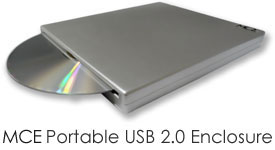
Remove the USB flash.
Hold down the Option key and press the power button.
When presented with the boot up options, select the OS X device. Allow the system to boot.
Check to make sure everything is in order.
Go to System Preferences and select the default startup device. This will be the OS that boots if you do NOT hold down the Option key.
At this point, you are basically done. You may wish to boot into Windows, check for updates, and do all those other Windows setup things. I recommend CCleaner for keeping Windows stable.
You can order an enclosure that lets you use your DVD drive externally.
Hold down the Option key and press the power button.
When presented with the boot up options, select the OS X device. Allow the system to boot.
Check to make sure everything is in order.
Go to System Preferences and select the default startup device. This will be the OS that boots if you do NOT hold down the Option key.
At this point, you are basically done. You may wish to boot into Windows, check for updates, and do all those other Windows setup things. I recommend CCleaner for keeping Windows stable.
You can order an enclosure that lets you use your DVD drive externally.